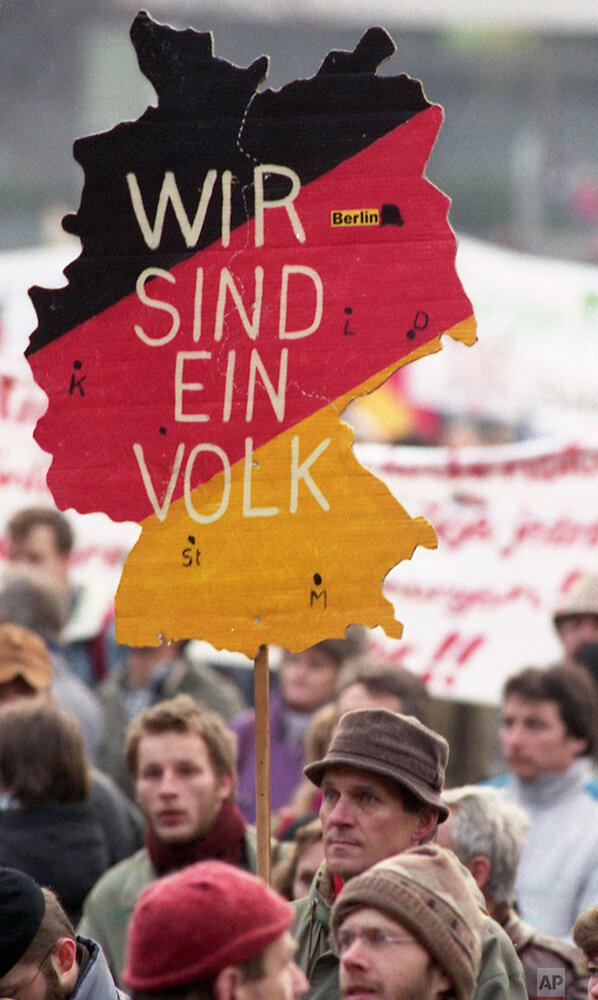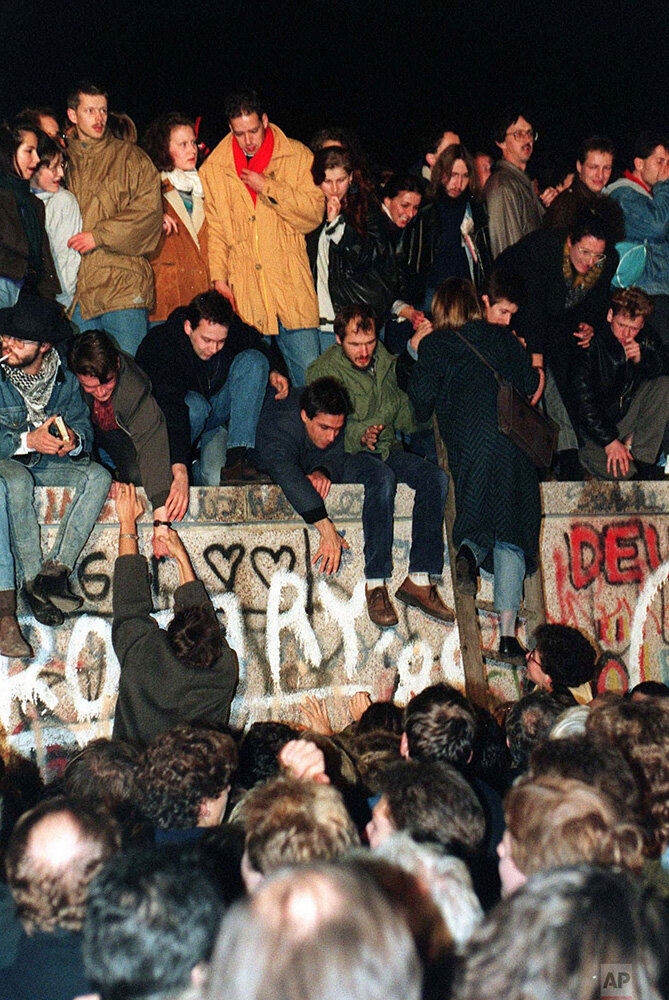Berlin Wall fell 30 years ago, leading to Germany's reunification
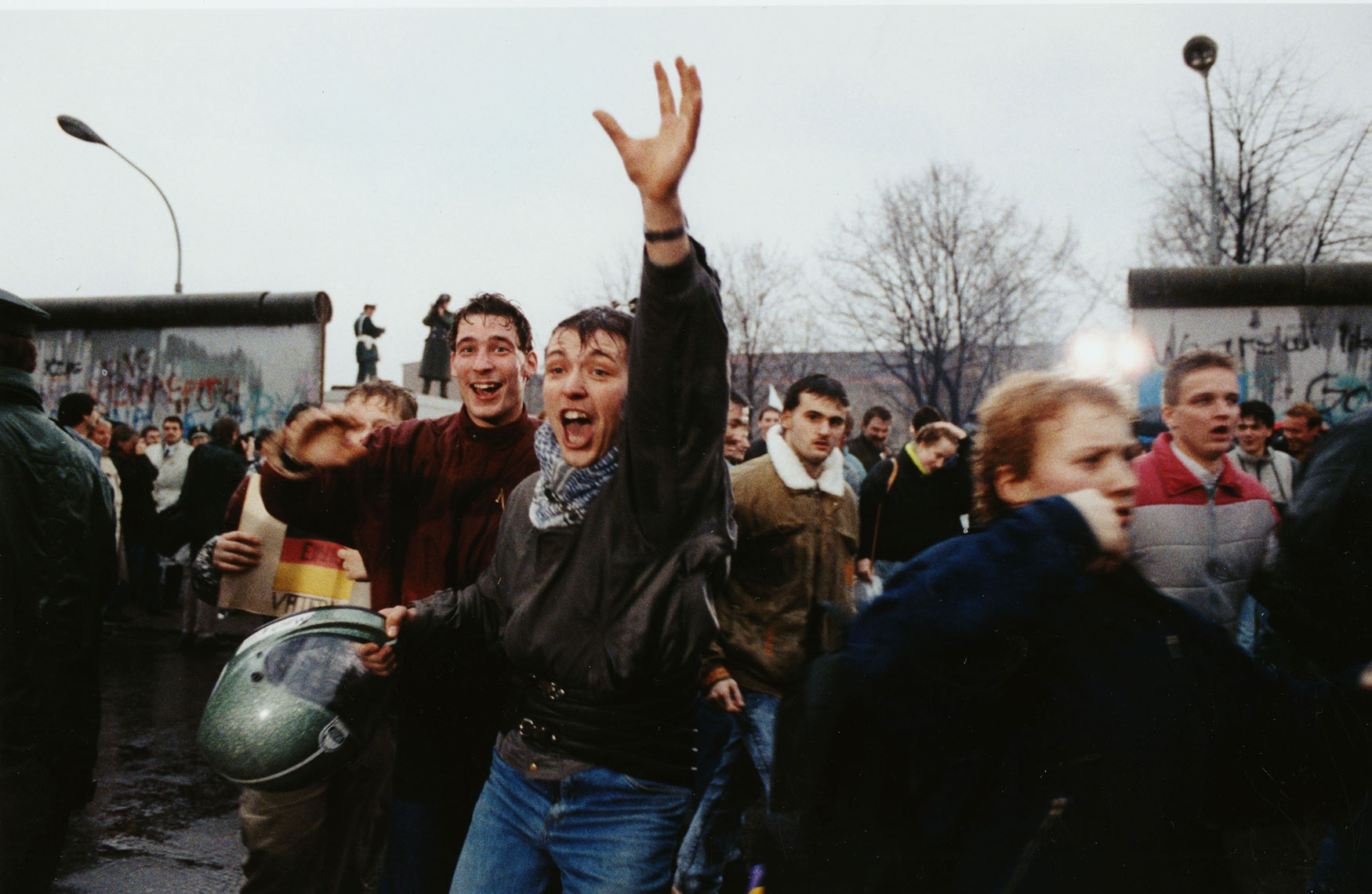
The fall of the Berlin Wall on Nov. 9, 1989 followed months of turmoil in communist East Germany and was the starting point for Germany’s reunification less than a year later.
Pressure on the hard-line leadership in East Berlin mounted through the summer and autumn. East Germans fled to the West first via Hungary, which started dismantling its border fortifications, and later holed up in the West German Embassy in Prague, from where they were taken by train to West Germany.
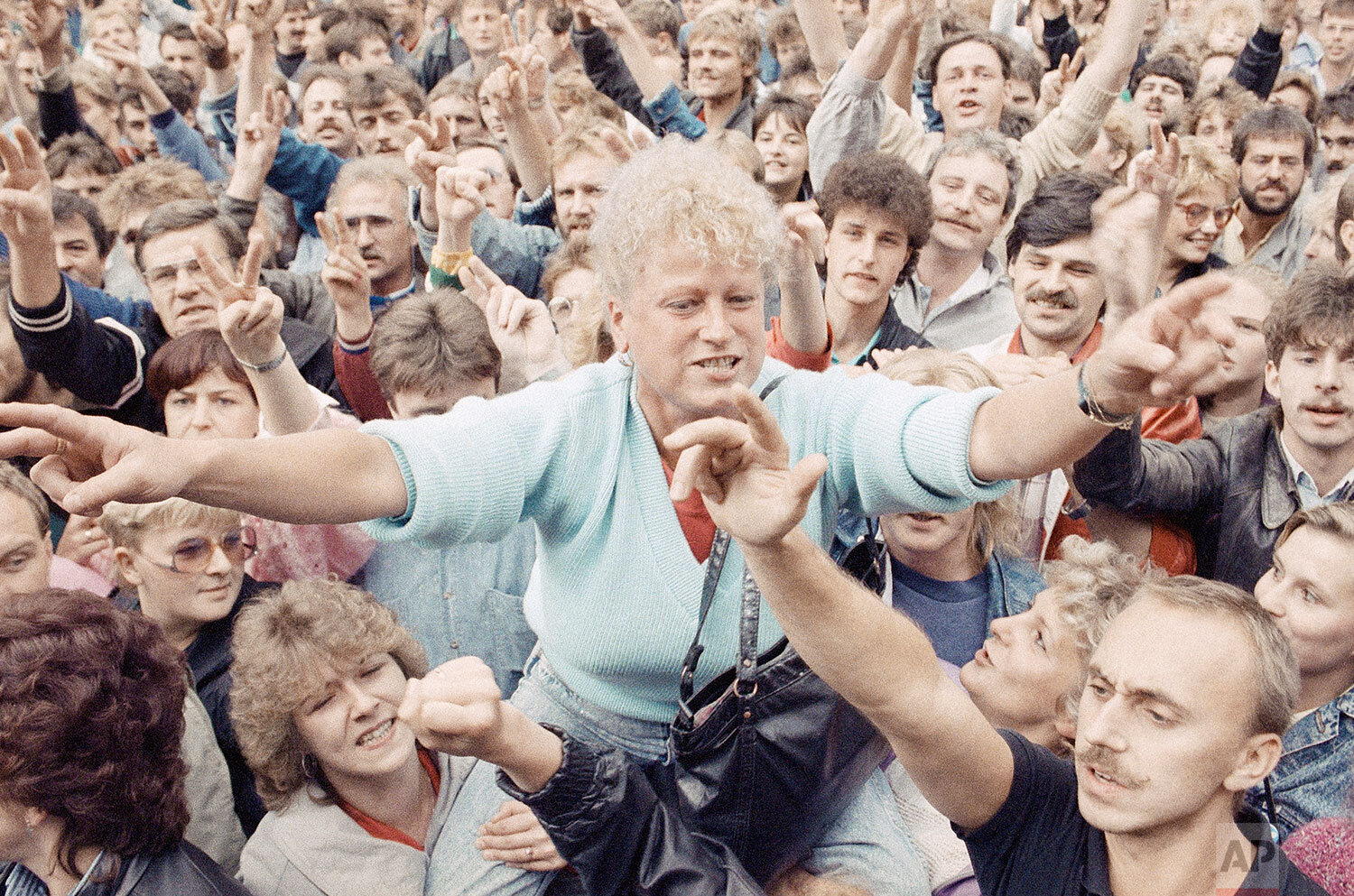
East German demonstrators raise their hands in a victory sign during a demonstration in Leipzig, East Germany, Sept. 4, 1989. (AP Photo/Rainer Klostermeier)
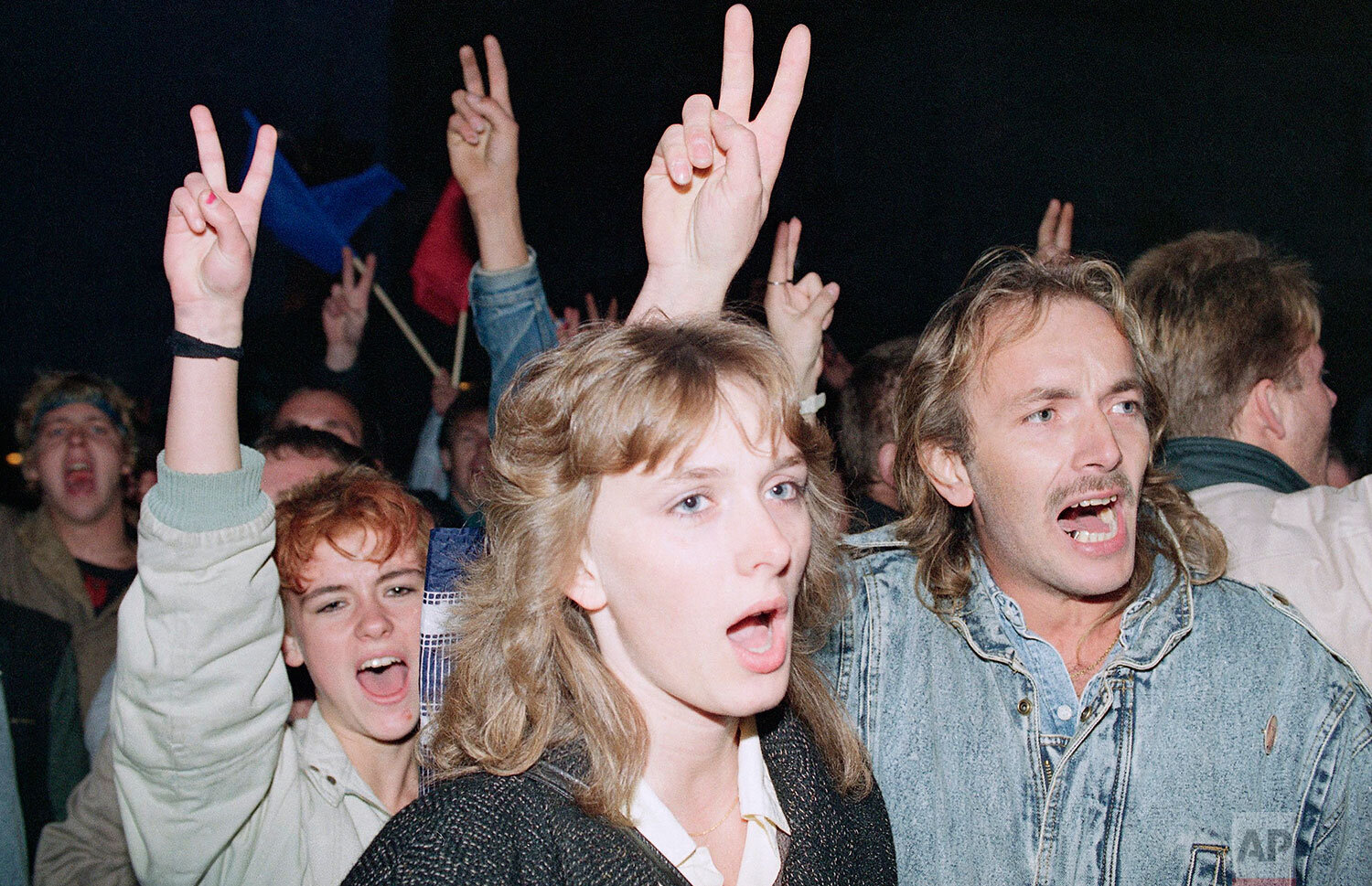
East German demonstrators flash victory signs as they demand democratic reforms in a massive protest in downtown East Berlin, Oct. 7, 1989. (AP Photo/Heribert Proepper)
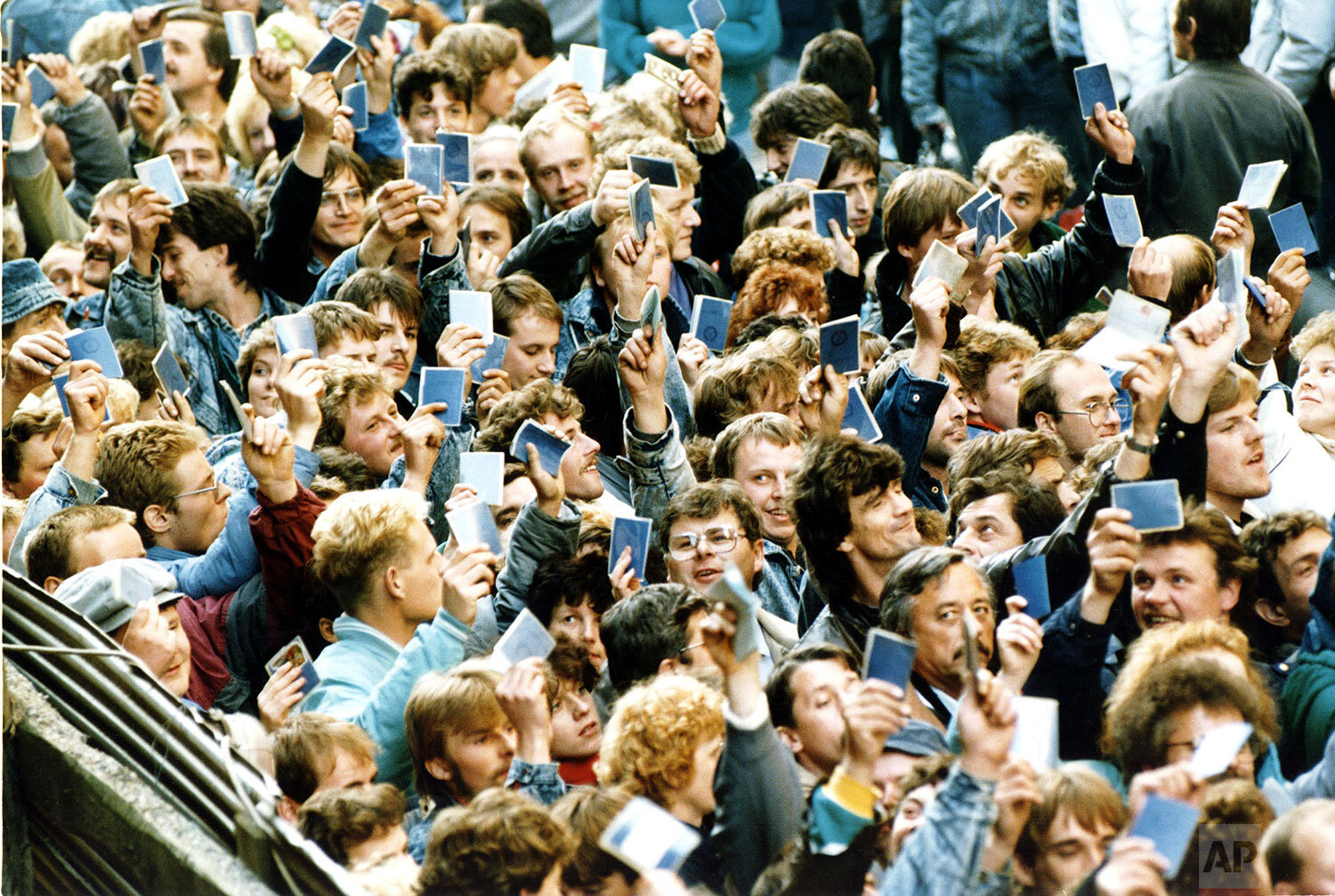
East German refugees wave while holding their travel documents in hands as they are about to enter the busses to take them to the special trains bound for West Germany in Prague, October 4, 1989. (AP Photo/Dieter Endlicher)
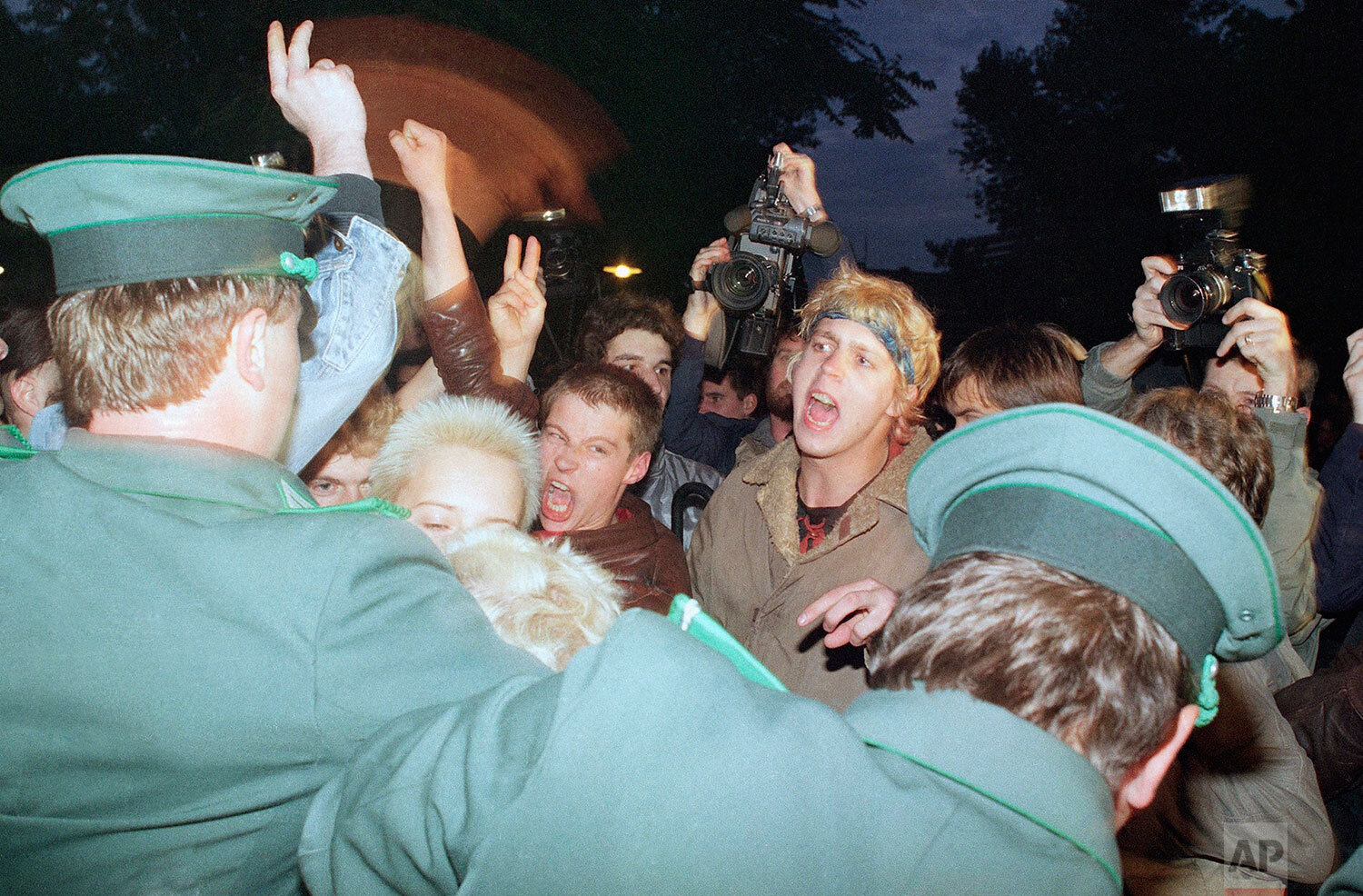
East German policemen, foreground, try to stop demonstrators from moving toward the East German parliament building, Oct. 7, 1989 where Soviet President Mikhail S. Gorbachev attended a reception. (AP Photo/Jockel Finck)
At home, East Germans took to the streets in unprecedented demonstrations for freedom of assembly and travel, staging growing protests every Monday in Leipzig. On Nov. 4, some 500,000 people gathered in East Berlin for the country’s biggest pro-democracy protest.
On the evening of Nov. 9, East Germany opened its border amid scenes of celebration. After Politburo spokesman Guenter Schabowski said the country was lifting restrictions on travel across its border with West Germany “immediately,” East Berliners flocked to border crossings.
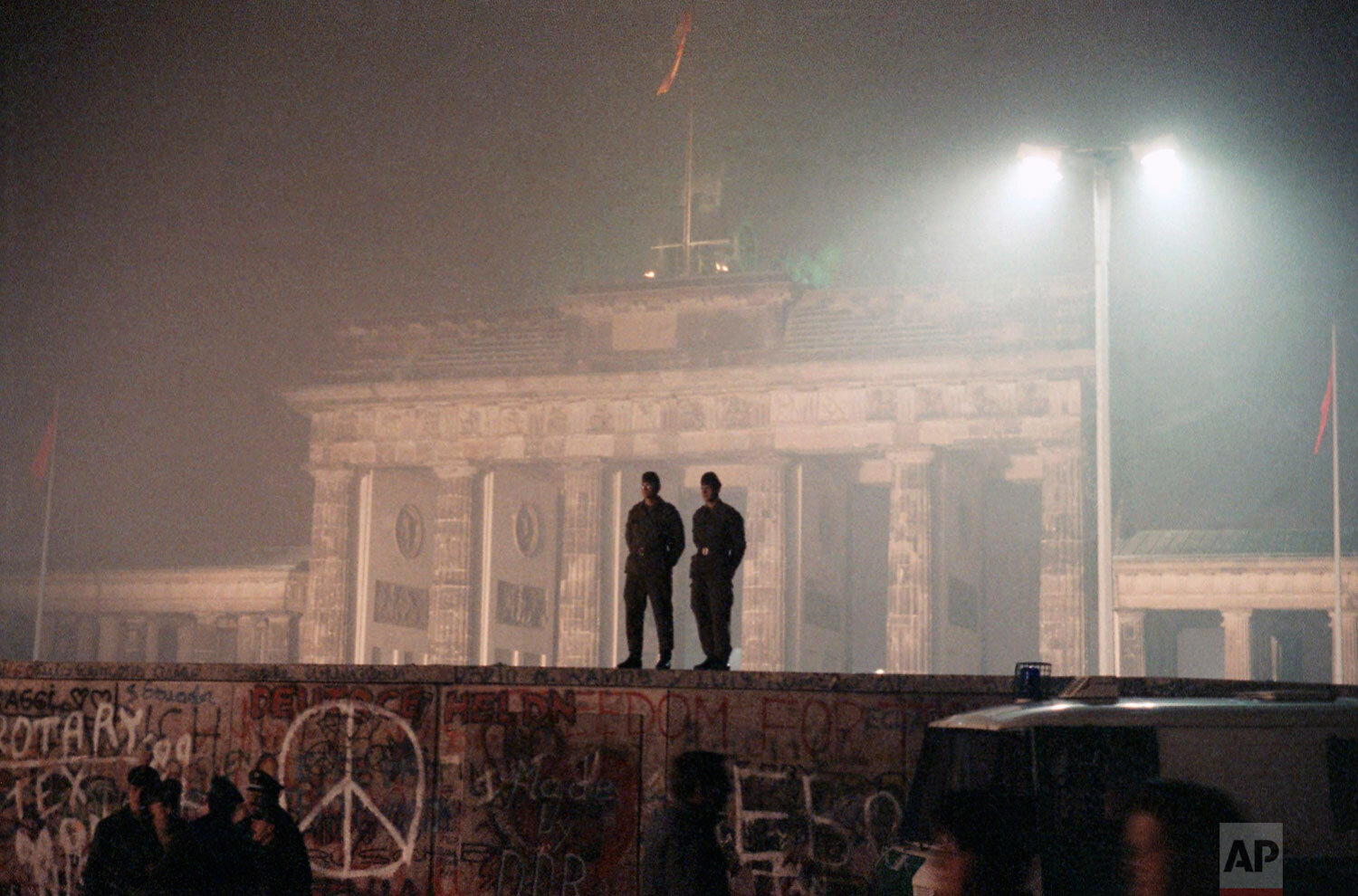
Two East German border guards patrolled atop of Berlin Wall with the illuminated Brandenburg Gate in background, in Berlin, Nov. 14, 1989. (AP Photo/Jockel Finck)

A man hammers away at the Berlin Wall on Nov. 12, 1989 as the border barrier between East and West Germany was torn down after 28 years, symbolically ending the Cold War. (AP Photo/John Gaps III)

East German border guards use a hose to discourage West Berliners near Brandenburg Gate, in Berlin, Nov. 11, 1989, as citizens from the west tried to demolish the wall, demanding it be pulled down. (AP Photo/Lionel Cironneau)

Germans from East and West stand on the Berlin Wall in front of the Brandenburg Gate in this Nov. 10, 1989, photo, one day after the wall opened. (AP Photo)
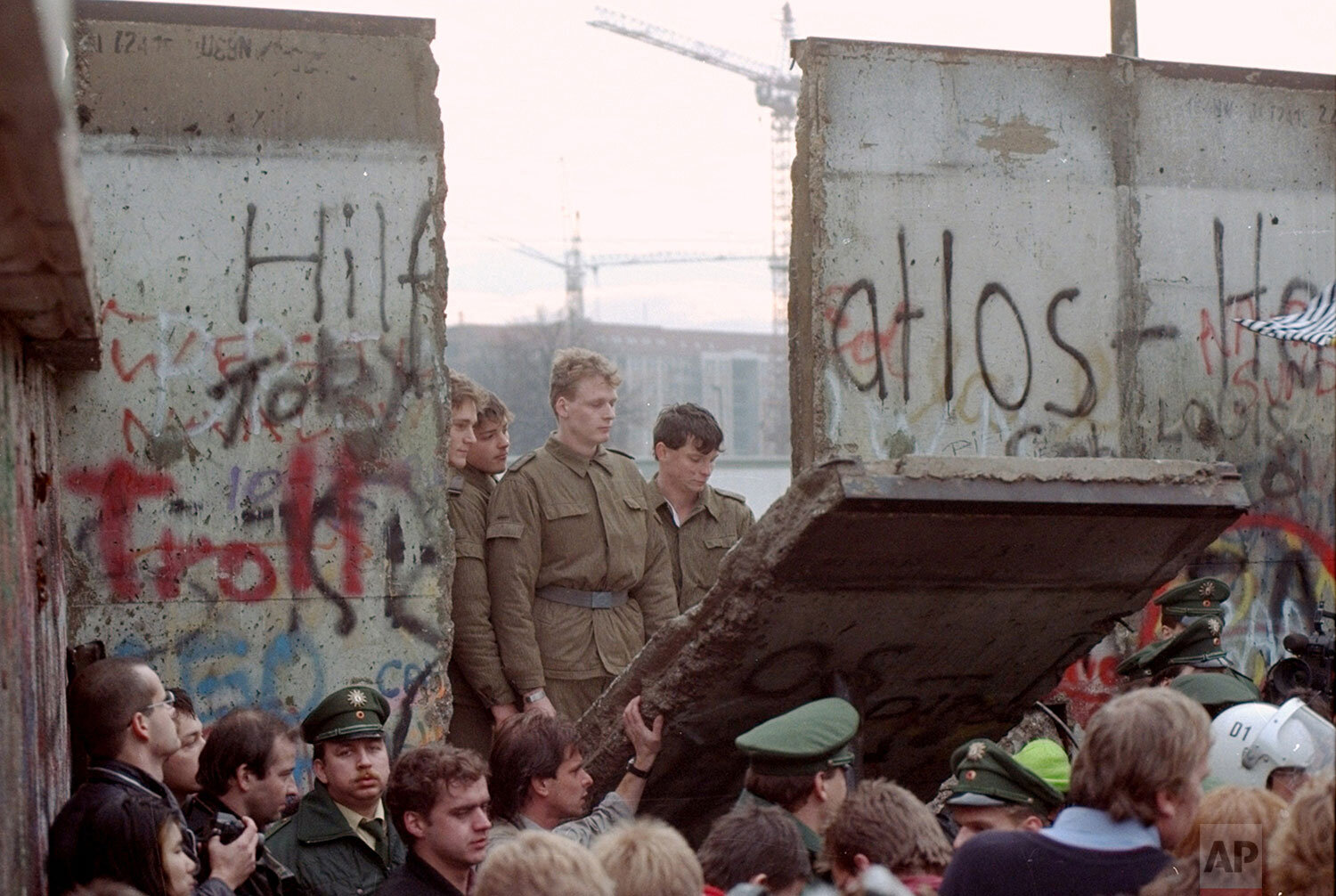
East German border guards are seen through a gap in the Berlin wall after demonstrators pulled down a segment of the wall at Brandenburg Gate, Berlin, Nov. 11, 1989. (AP Photo/Lionel Cironneau)
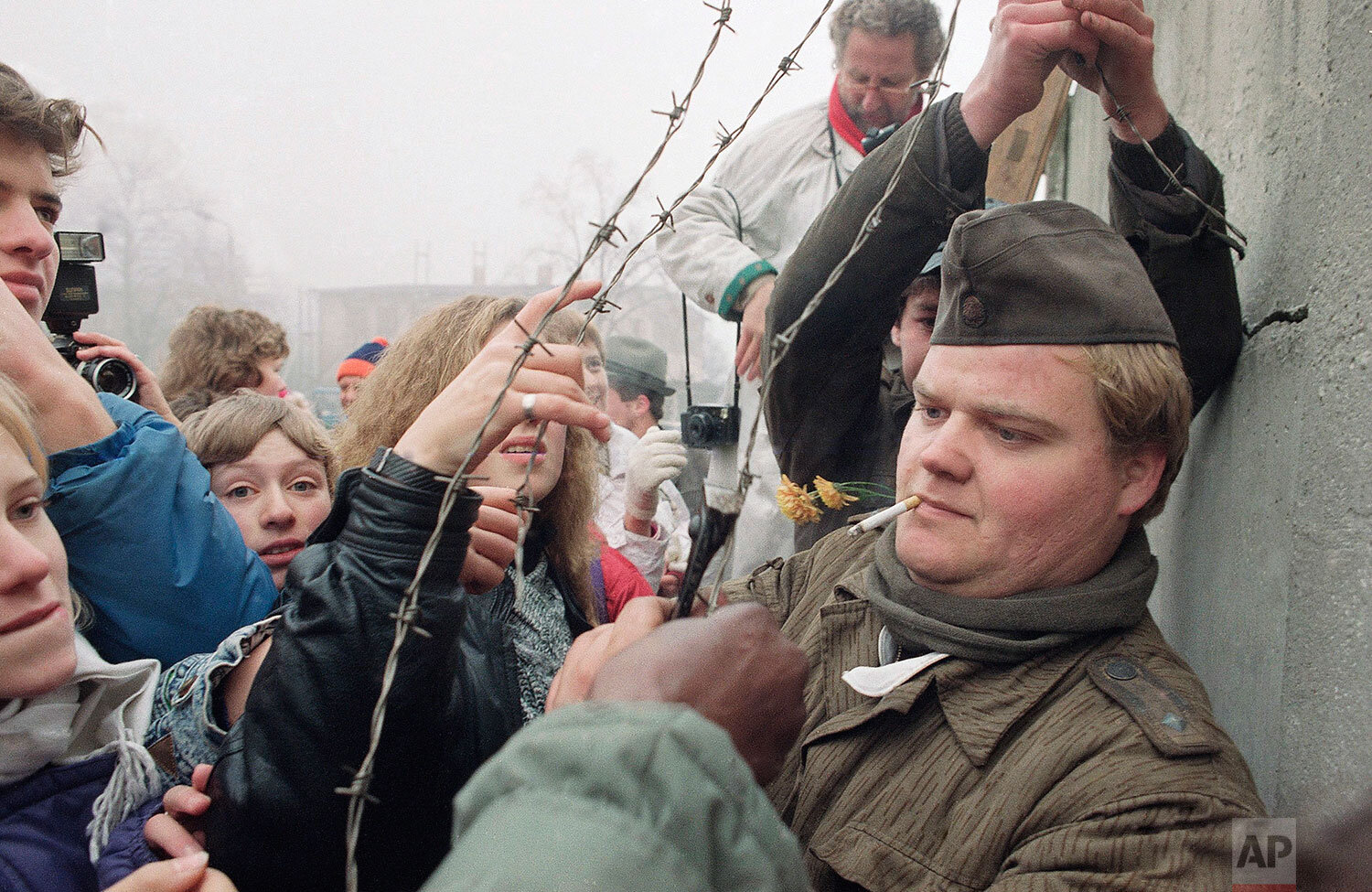
An East German border guard presents pieces of barbed wire he cut off the Berlin Wall at Ostpreussendamm passage in Berlin, Nov. 14, 1989. (AP Photo/John Gaps III)
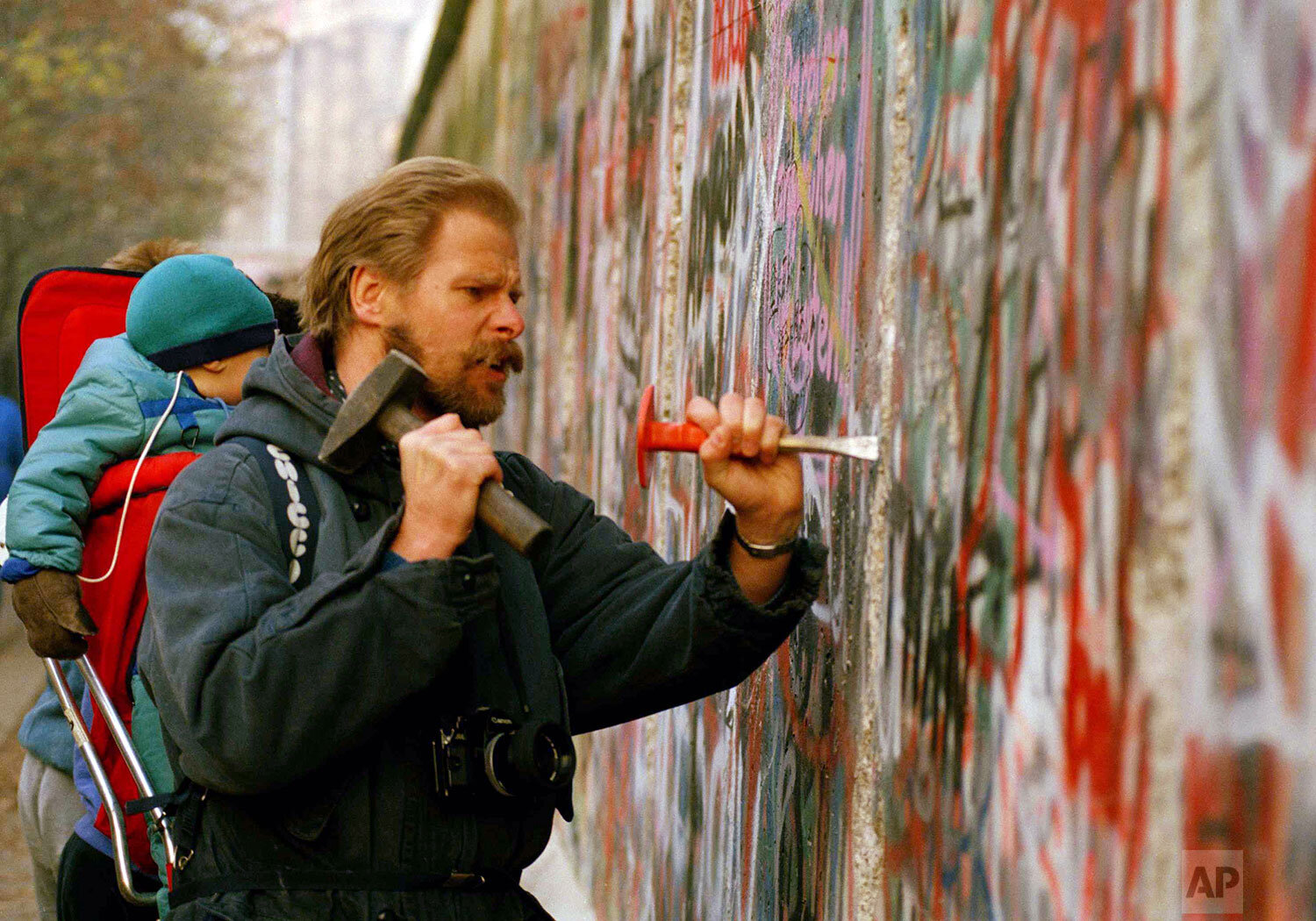
A sight-seeing West Berliner carries his baby and uses a hammer and chisel to carve out a piece of the Berlin Wall, Nov. 14, 1989. (AP Photo/Lutz Schmidt)
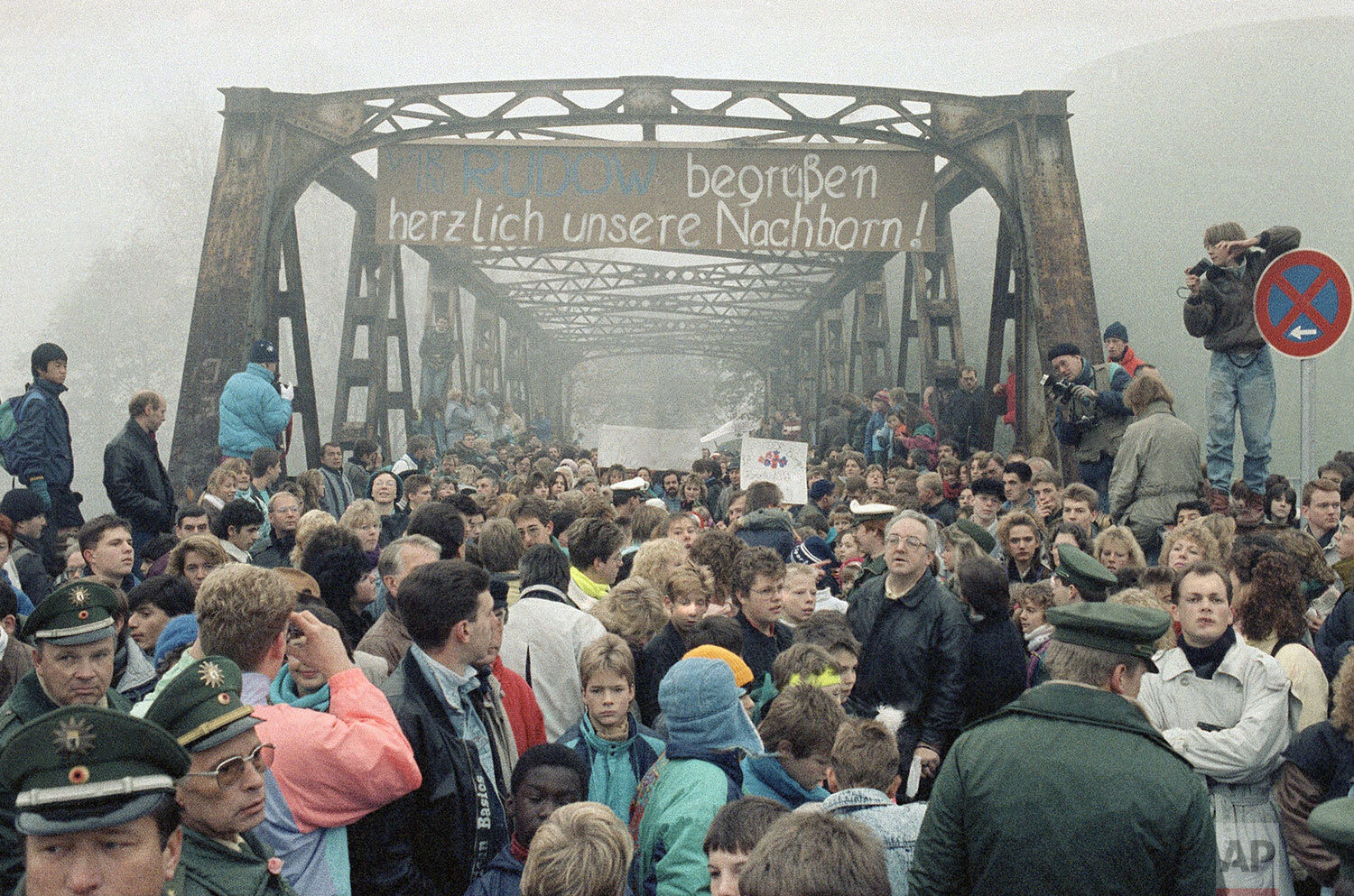
People crowding Masante Bridge at Stubenrauchstrasse in Berlin on Tuesday, Nov. 14, 1989, to celebrate opening of another border passage between East and West Berlin. In this image taken from West Berlin side of the wall, the banner reads: "We are welcoming our neighbours." (AP Photo/Udo Weitz)
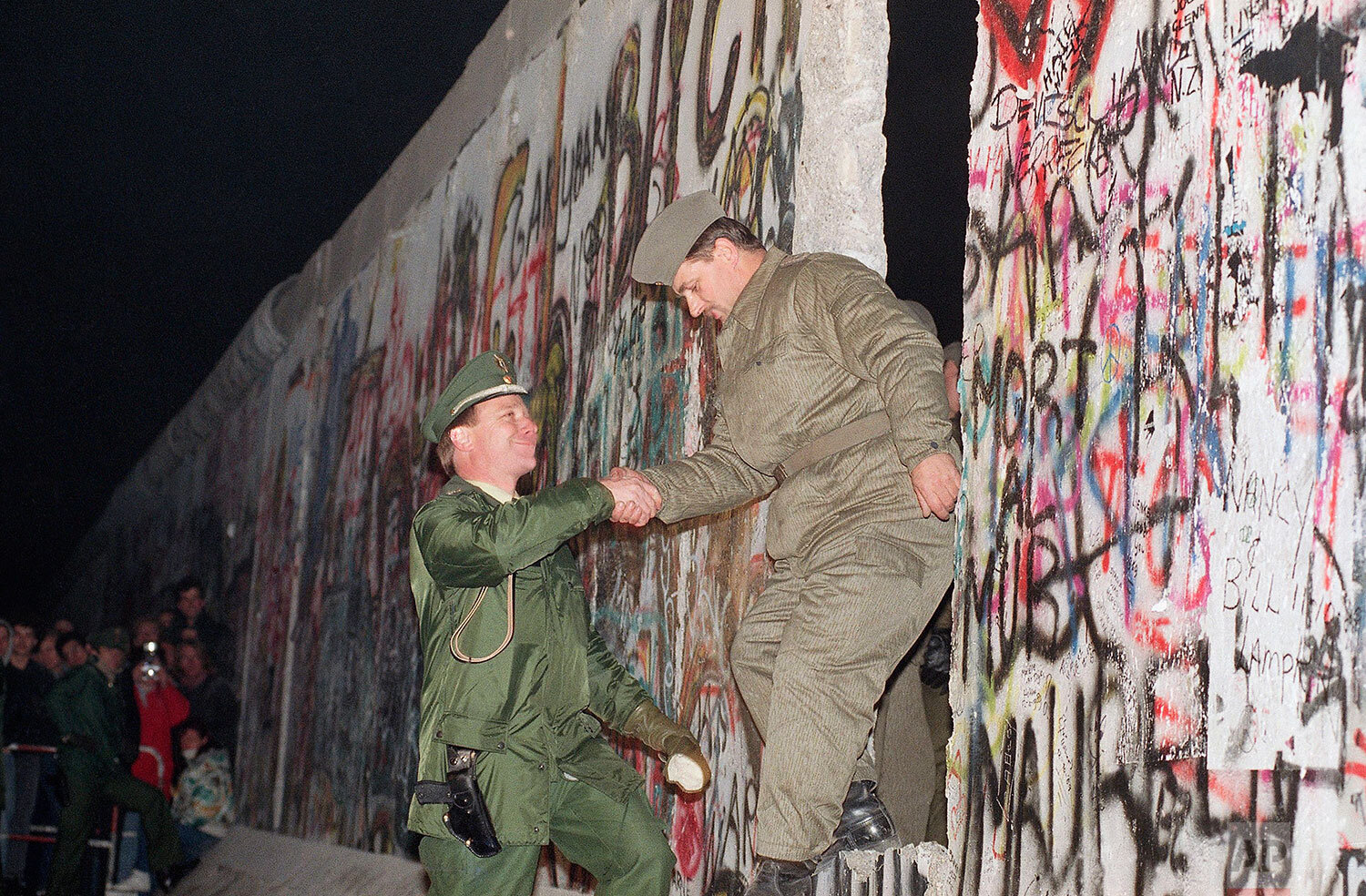
A West German policeman, left, gives a helping hand to an East German border guard who climbs through a gap of the Berlin Wall when East Germany opened another passage at Potsdamer Platz in Berlin, Nov. 12, 1989. (AP Photo/Thomas Kienzle)
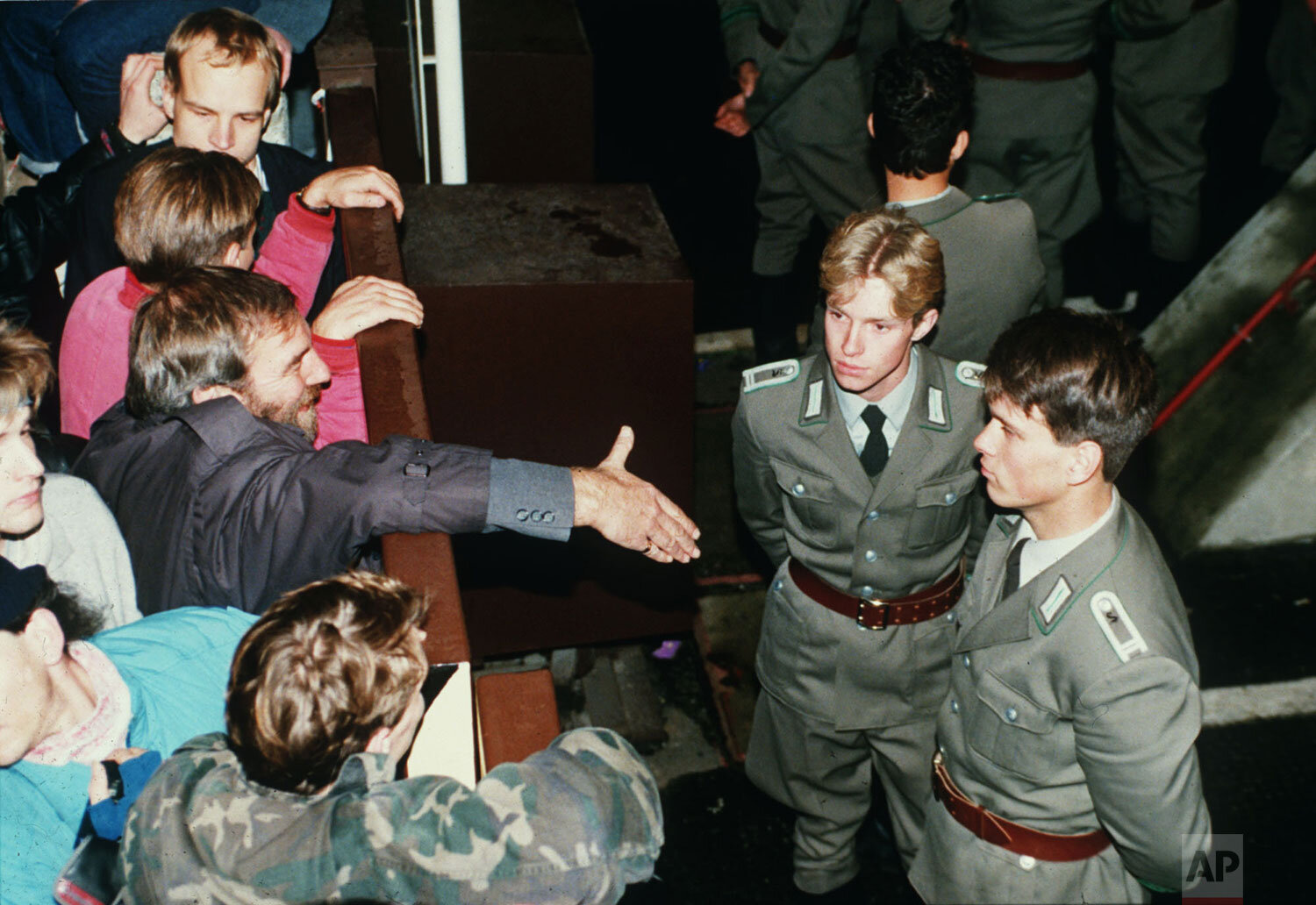
East German border policemen, right, refuse to shake hands with a Berliner who stretches out his hand over the border fence near Checkpoint Charlie border crossing point, Nov. 10, 1989, after the borders were opened according to the announcement by the East German government. (AP Photo/Lutz Schmidt)
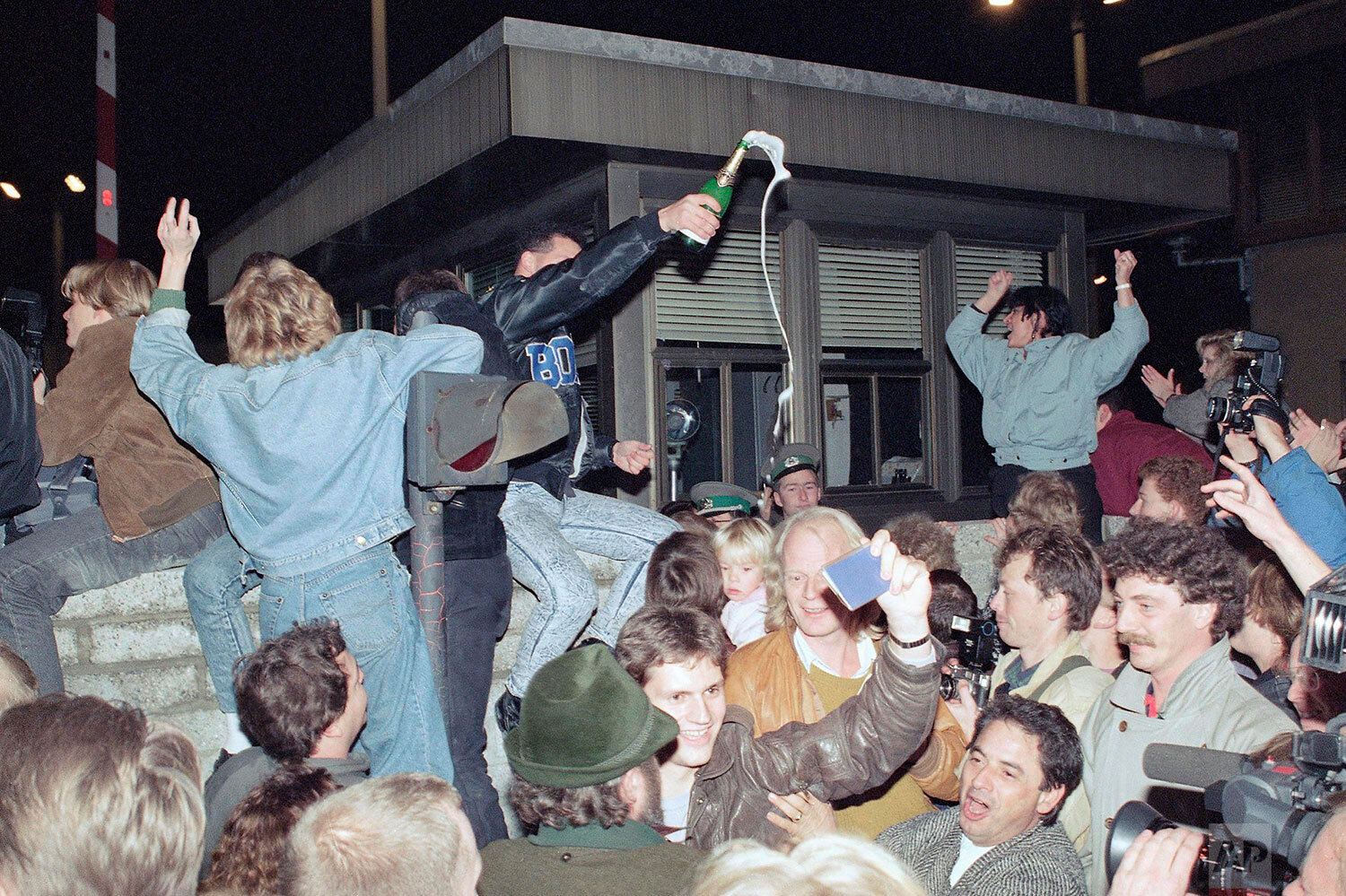
East and West Berliners celebrate in front of a control station on East Berlin territory, Nov. 10, 1989, during the opening of the borders to the West following the announcement by the East German government that the border to the West would be open. (AP Photo/Jockel Finck)
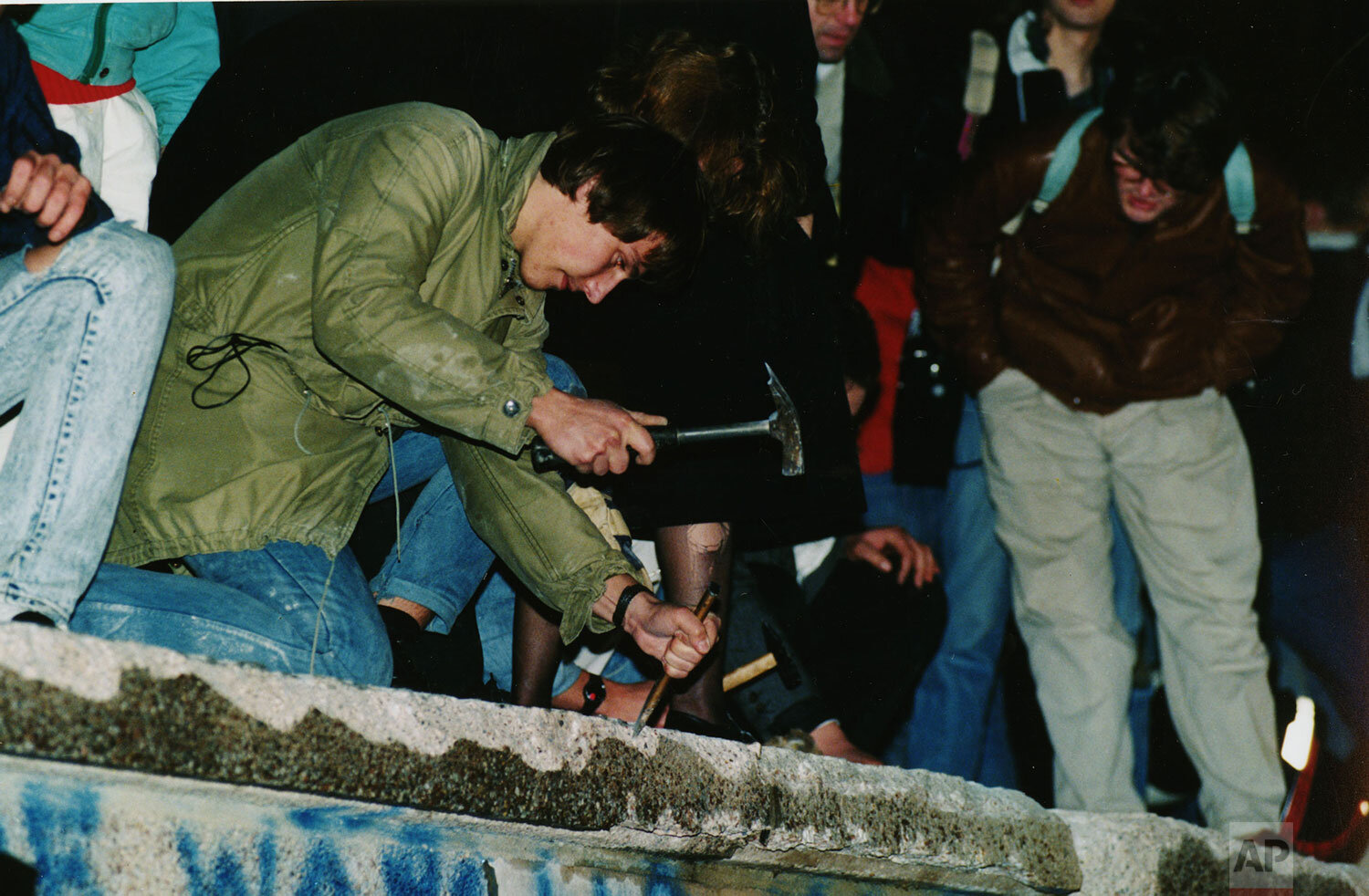
A man sits atop the wall near the Brandenburg Gate, Nov. 10, 1989 in Germany as he chisels a piece of the wall that divided East and West Berlin, after the border opened, unifying East and West Germany. (AP Photo/Jockel Finck)
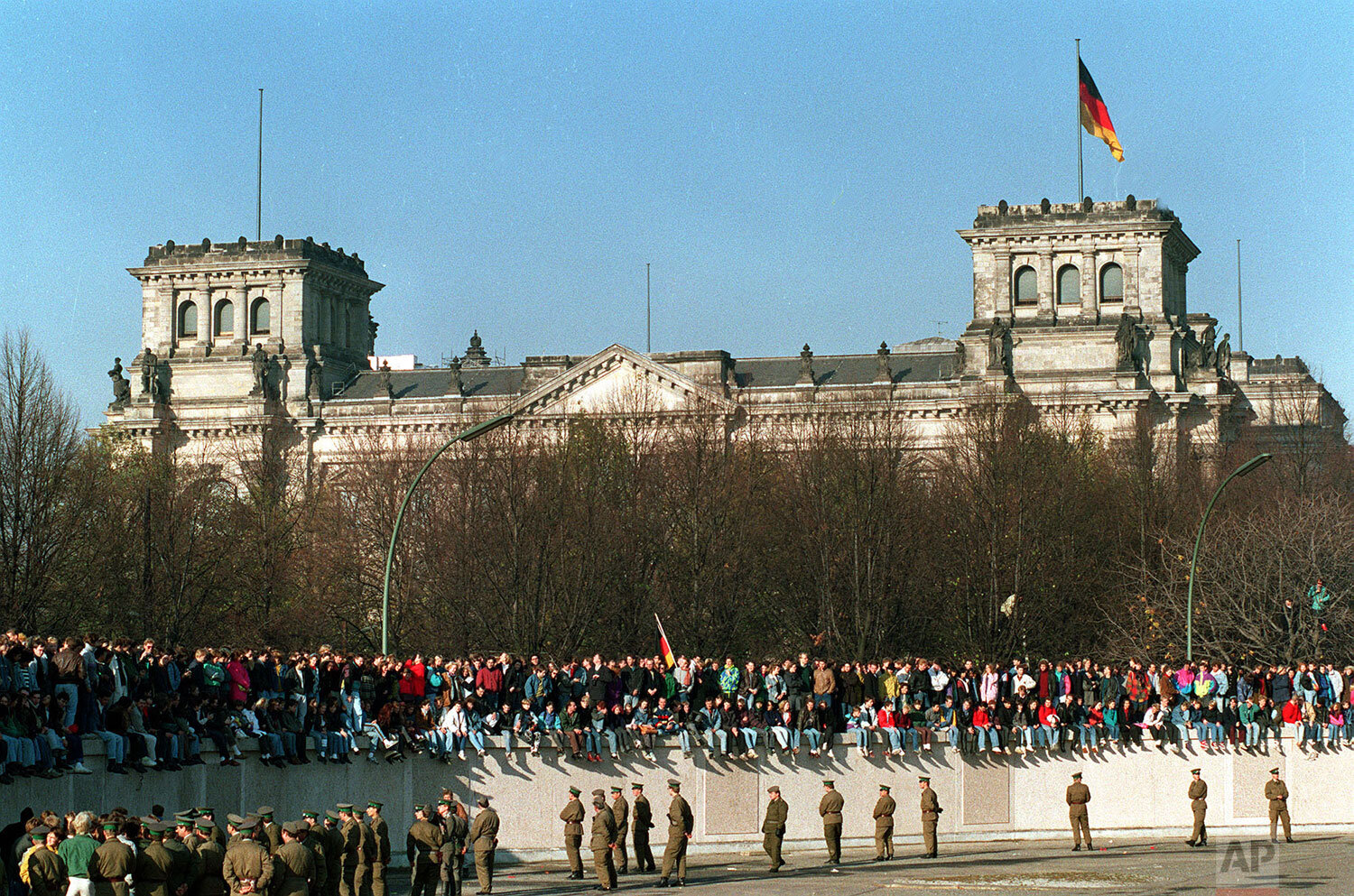
Germans from East and West stand on the Berlin Wall in front of the the Reichstag Building, Nov. 10, 1989, one day after the wall opened. (AP Photo)
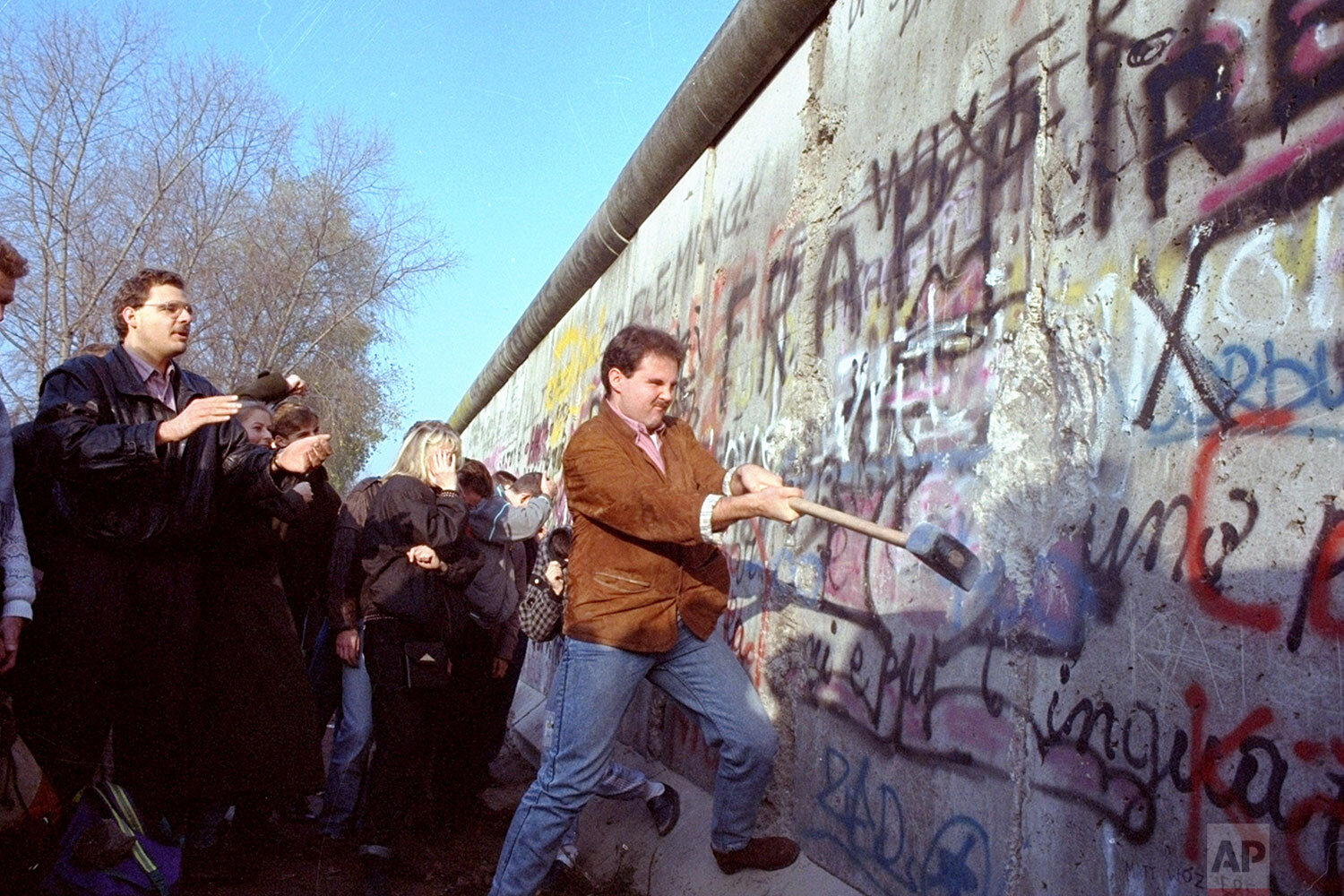
An unidentified West Berliner swings a sledgehammer, trying to destroy the Berlin Wall near Potsdamer Platz, on November 12, 1989, where a new passage was opened nearby. (AP Photo/John Gaps III)
Border guards had received no orders to let anyone across but gave up trying to hold back the crowds. In the weeks that followed, new border crossings opened up _ including at Berlin’s landmark Brandenburg Gate _ and people chipped away at what had long seemed an impregnable barrier.
East Germany and West Germany were united on Oct. 3, 1990.
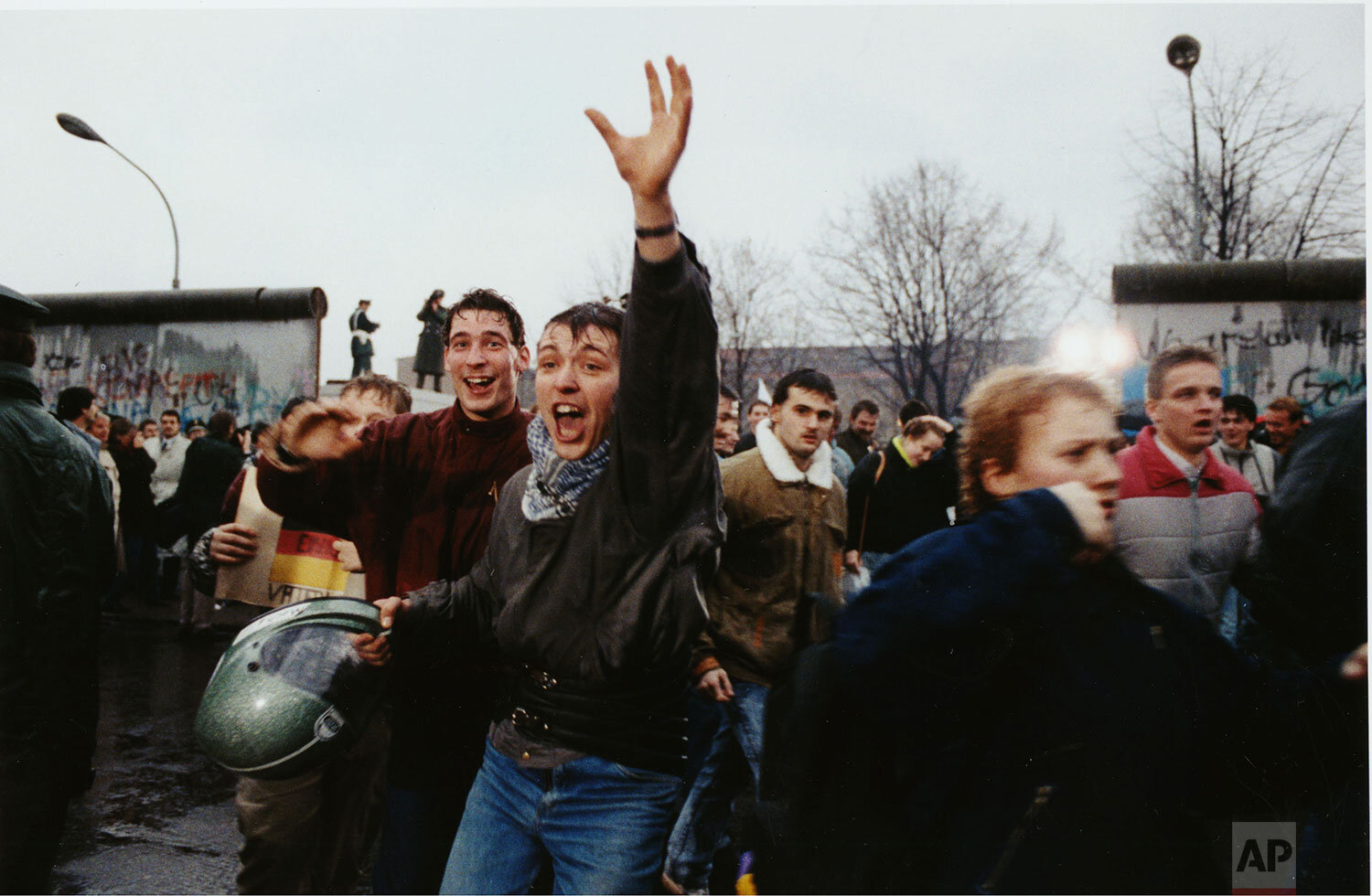
Young East Berliners shout for joy as they run into West Berlin through an opening in the Berlin Wall near the Brandenburg Gate, Fri., Dec. 23, 1989. (AP Photo/Hansjoerg Krauss)

Two men from West and East Germany meet again and embrace each other after the arrival of a special train from Magdeburg at Helmstedt railway station, Nov. 10, 1989. (AP Photo/Claus Eckert)
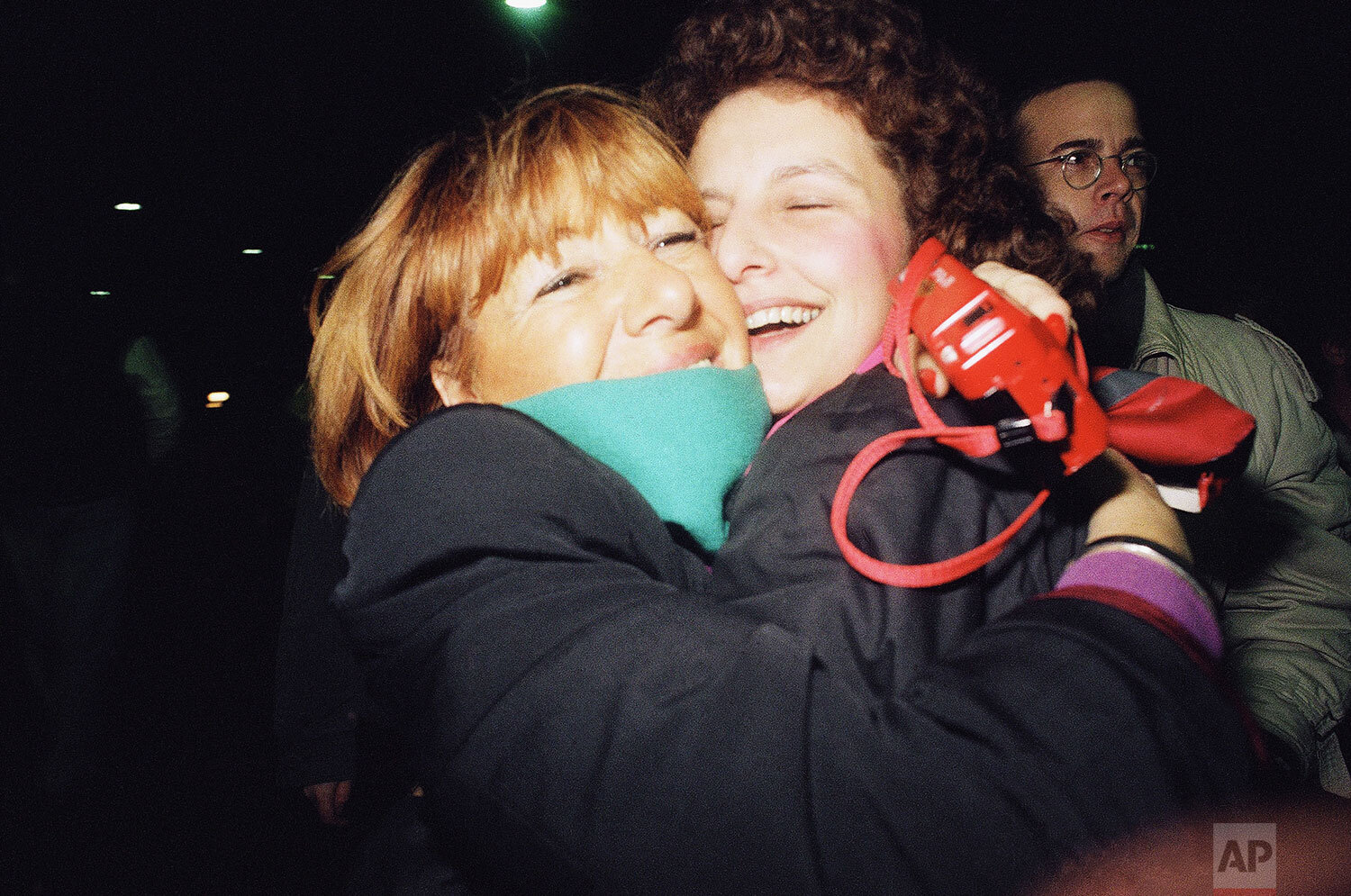
Two Berlin women hug each other at a border crossing point in West Berlin, Nov. 10, 1989 after the gates at the borders opened. (A Photo/Jockel Finck)
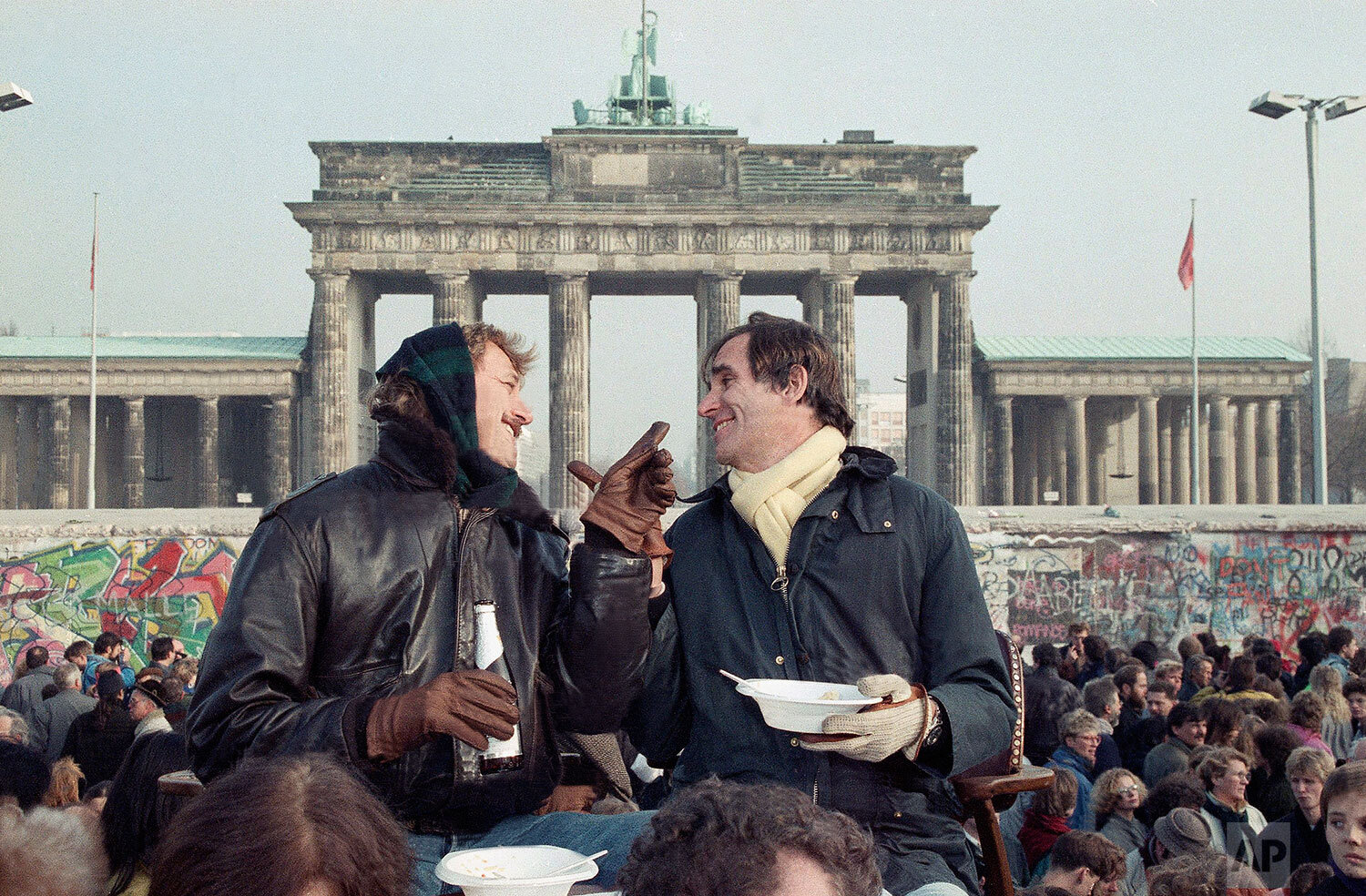
Two Berliners chat in front of Brandenburg Gate in Berlin, Nov. 12, 1989 while having lunch on a visitor's platform near the Berlin Wall. (AP Photo/Lionel Cironneau)
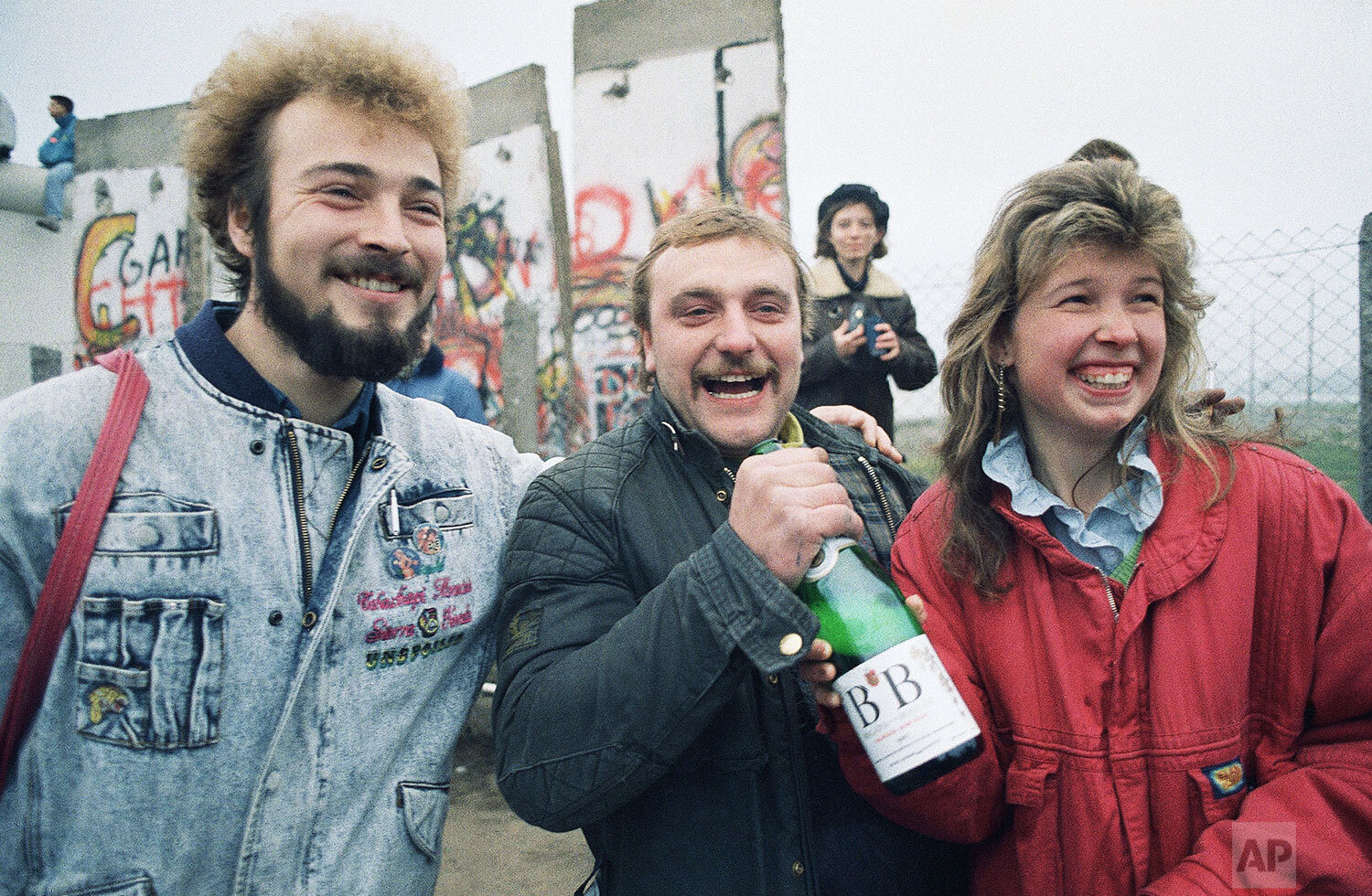
Bernd Mechelke of Ingolstadt, West Germany, welcomes his friends from Woltersdorf, East Germany with a bottle of champagne as they arrive in West Berlin, Nov. 12, 1989. (AP Photo/Thomas Kiezle)
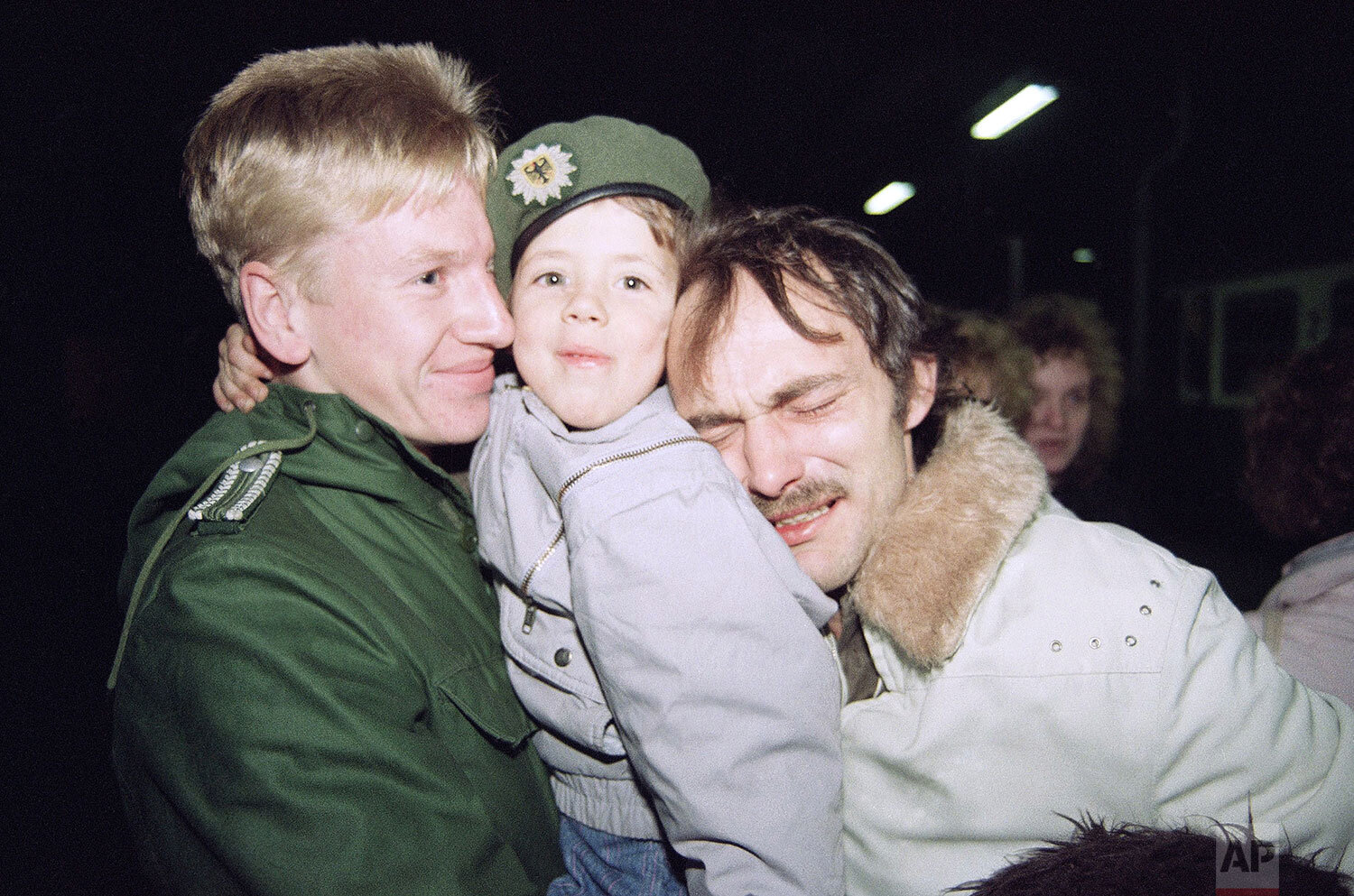
Heinz Joachim Nickel, right, a member of the East German opposition group "New Forum," is overcome with emotion as he and his son, Christian, center, arrive in Helmstedt, West Germany by train from East Germany, Nov. 11, 1989. (AP Photo/Claus Eckert)
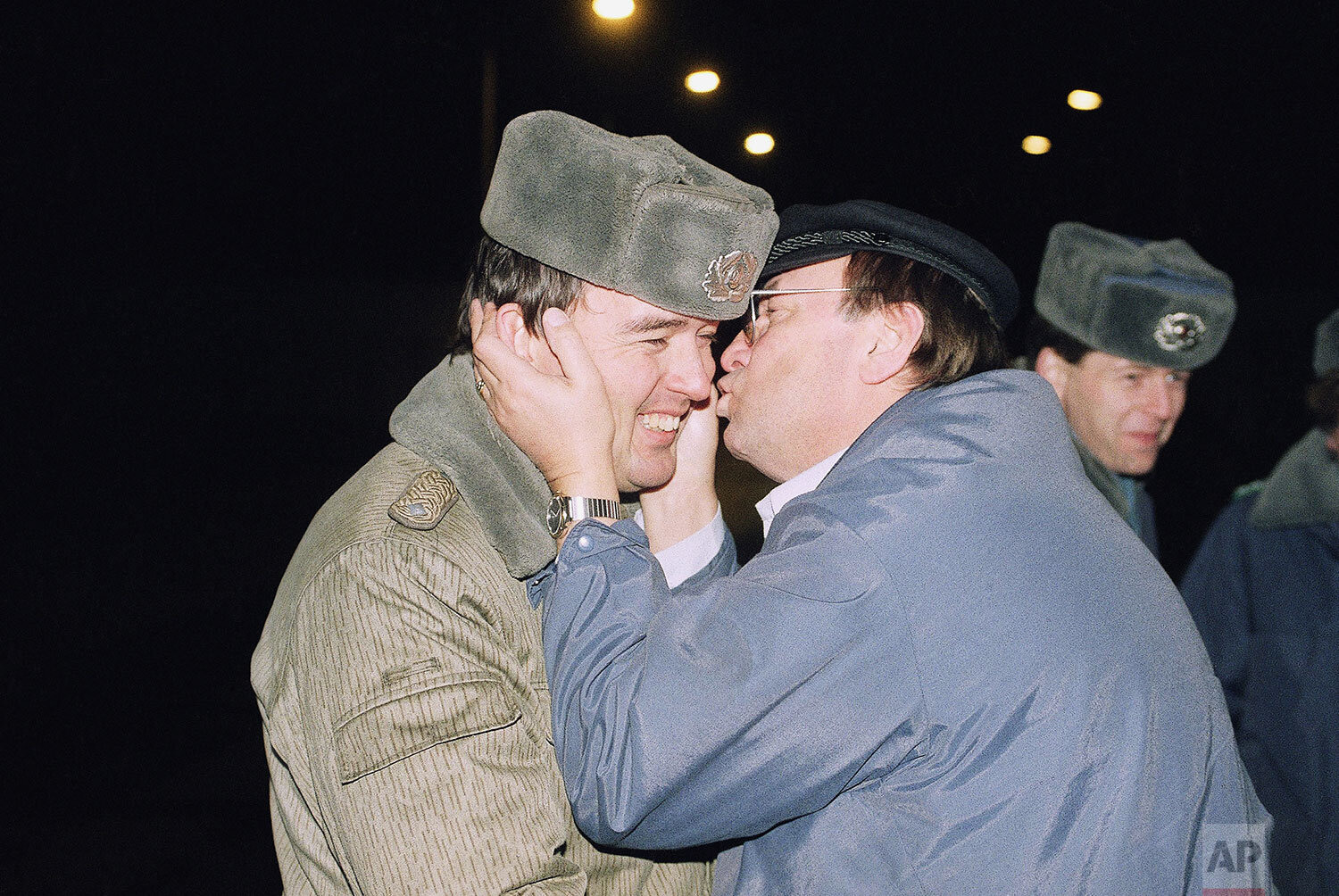
A West Berlin citizen holds the head of an East German border guard to kiss him after a new crossing point from East to West Berlin in the Zehlendorf district opened in Berlin, Dec. 11, 1989. (AP Photo/Lutz Schmidt)
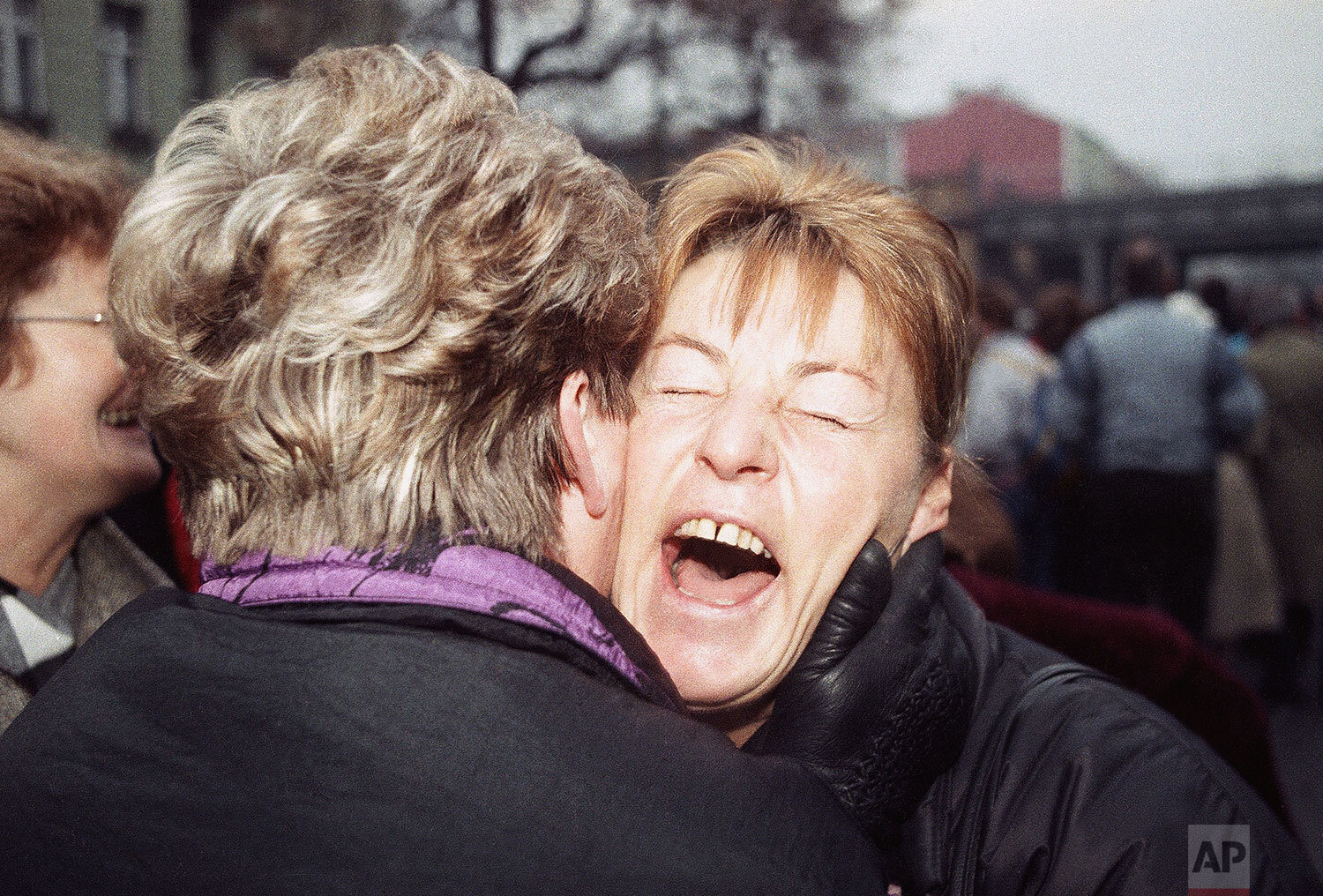
East German Rosemarie Doln is overwhelmed with emotion as she is welcomed by an unidentified relative at the opening of latest wall passage at Wollankstrasse in West Berlin's district of Wedding, Nov. 13, 1989 in Berlin. (AP Photo/John Gaps III)
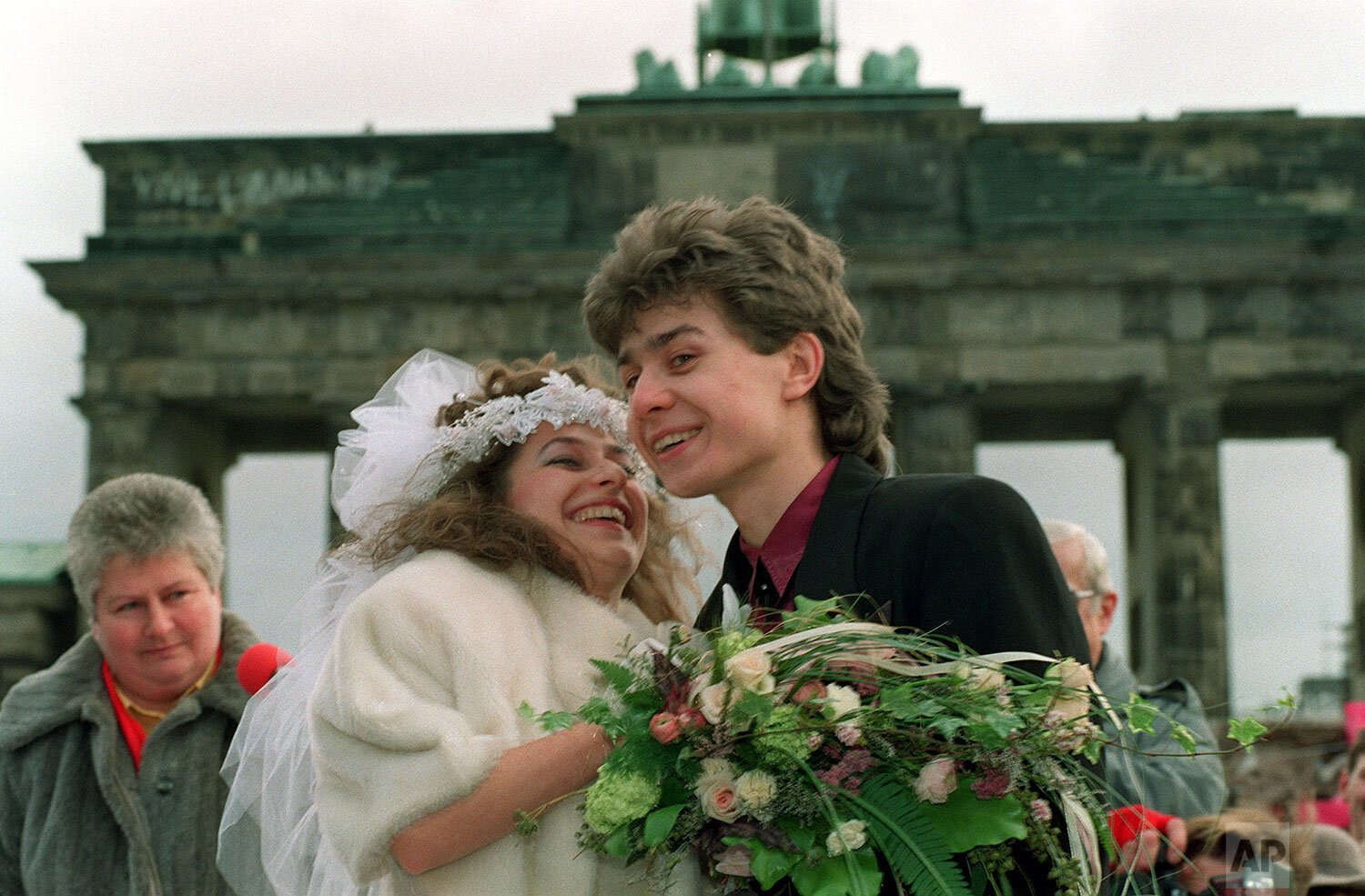
Barbara Hartung (21) from East Berlin and Oliver Matalla (21) from West Berlin smile happily after their wedding ceremony held in front of Brandenburg Gate, West Berlin, on Wednesday, February 14, 1990. (AP Photo/Rainer Klostermeier)
AP Corporate Archives contributed to this report.




